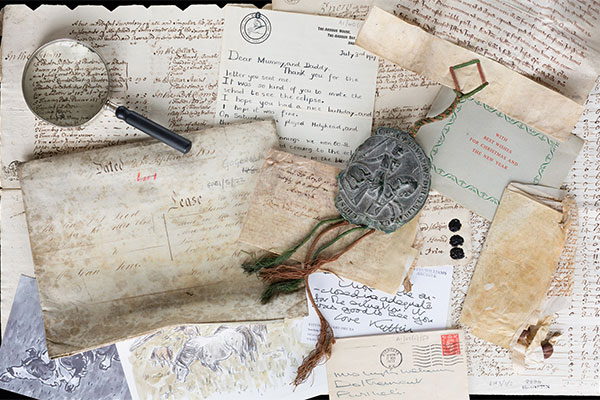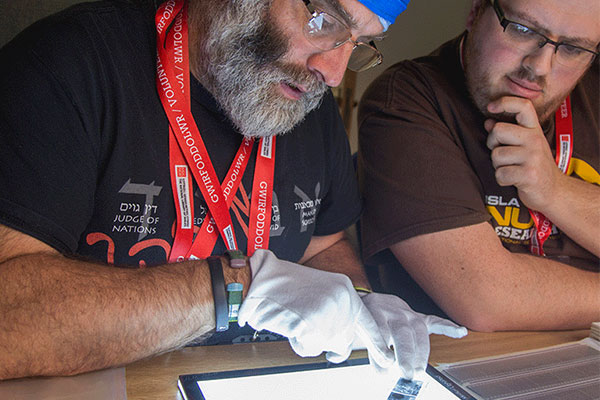Browsing through the different reading materials in the school’s library, one name which steps forward and was an influential figure in Welsh culture particularly during the late 18th and beginning of the 19th century, was William Owen Pughe. He is named as the Librarian for the ‘Society of Antient Britons’ between 1830-32, 1834-35, in one of the Annual Reports volumes for the school. William Owen Pughe was a lexicographer, editor and grammarian, antiquarian and poet. He left his native area in Meirionethshire for London in 1776 and lived in the capital for 30 years. Though he returned to Wales, after he’s inherited an estate in 1806, his ties with London still continued to be strong, which is demonstrated in his role as ‘Society of Antient Britons’. He was also the editor for ‘Y Greal’, the periodical for the Cymmrodorion and the Gwyneddigion, between 1805-1807.

Like his contemporaries, Pughe, made an important contribution to the literary and cultural life of Wales. His efforts contributed to Welsh scholarship during the 19th century because of his and his contemporaries eagerness to uncover, re-discover and publish the contents of ancient Welsh manuscripts. Amongst other collaborations, William Owen Pughe, helped Owain Myfyr, who had been assistant secretary at the time for Cymdeithas y Cymmrodorion and also President of Y Gwyneddigion, to publish Dafydd ap Gwilym’s poetry, for the first time in 1789. Both, along with Iolo Morganwg, were responsible for compiling and publishing ‘The Myvyrian archaeology of Wales’, between 1801 and 1807, a compilation of Welsh language manuscripts containing Brutiau (Chronicles) and early Welsh poetry. The Cymmrodorion were a prominent influence in promoting other educational and cultural ventures established in Wales, such as the University of Wales at the end of the 19th century. It played an important role in the discussions regarding the creation of educational and national institutions in Wales during the 20th century.
The Annual Reports of the School show that there were continued Welsh aristocratic and important patron links between Wales and the school. Amongst the list of School Governors and Subscribers (who were also members of o ‘The Most Honourable and Loyal Society of Antient Britons’) there was a local link with Aberystwyth, for example, Lord Lisburne, Trawscoed Estate, subscribed £5/5s/5d for 1889. One of Lord Lisburne’s ancestors was amongst the founders of ‘The Most Honourable and Loyal Society of Antient Britons’ when it was established in 1714-15 in a dinner held at Haberdashers Hall to appoint the society’s President and stewarts.
The 1890 report also lists the contribution made by Squire Loxdale, Castle Hill, Llanilar, Aberystwyth who subscribed £1/1s in the same year; Major Price-Lewes, Ty-glyn Aeron, Ciliau Aeron, Ceredigion subscribed £1/1s in 1889; Theresa, Dowager Marchioness Londonderry, Plas Machynlleth, who subscribed £5/5s for 1889. Another individual in the history of Aberystwyth was Thomas Savin, Oswestry, the first owner of the Castle Hotel, Aberystwyth, before it was eventually sold in 1867 because of debt. The hotel was bought as one of the first buildings of the University of Wales, Aberystwyth and is also known as the ‘Old College’, located on Aberystwyth seafront.
Amongst the school’s other Governors and Subscribers in 1890, and who were prominent in Welsh life at the time, were Sir R. Williams Bulkeley, Beaumaris; David Davies, Broneirion, Llandinam; Lord Dynevor, Dynevor Castle, Llandeilo; the Right Honourable W.E Gladstone, Hawarden, Chester; Lord Harlech, Brogyntyn, Oswestry; Stuart Rendel, Liberal M.P, 4 Whitehall Gardens, London; Lady Aberdare and Sir W. Williams Wynn, Wynnstay, Ruabon and his wife and mother, the Lady Dowager Williams Wynn, Llangedwyn, Oswestry.
Recognising its royal links were very important to the school’s profile and it always paid homage to the king/queen as its Honorary President. The royal heraldry always appeared amongst the first few pages of the school’s annual report to emphasise the loyalty of the pupils and school staff to the monarchy. Annual dinners were held to demonstrate these links as well as being fund-raising events for the school. The First Grand Fancy and Full Dress Cambrian Ball for the benefit of the Welsh Charity School, Gray’s Inn, Road, took place at Willis’s Rooms, King Street, St.James’s Square, 20th June, 1823. The school’s 185th anniversary was held at the Holborn Restaurant on March 1, 1900, and John Thomas (Pencerdd Gwalia) was listed as one of the musical items performing a harp solo. John Thomas at the time was also the Royal Harpist at the time and had been appointed to the role since 1871 when he was appointed by Queen Victoria. During his career he was appointed a harp tutor at the Royal College of Music and at the Guildhall School of Music.


The school’s library contained a range of materials and books on various aspects of Welsh history, culture, literature and heritage. Amongst these were works by Edward Jones such as ‘Musical and Poetical Relicks of the Welsh Bards… to the bardic Tunes are added Variations for the Harp, Piano-Forte, Violin, or Flute. Dedicated, by Permission, to His Royal Highness the Prince of Wales, by Edward Jones, Teacher of the Harp, and Bard to the Prince’.
Edward Jones (1752-1824) arrived in London c.1775 and by the end of the century he had been appointed Royal Harpist to the Prince of Wales. He was also known as the ‘Bard of the King’. He came from a musical family whose roots were in Meirionethshire, had been an adjudicator on harp playing and was an enthusiastic collector of Welsh folk-songs. He published a number of arrangements for harp and native folk-songs and penillion. ‘Musical and Poetical Relicks of the Welsh Bards’ was originally published in 1784 and contained Welsh poetry and folk-songs, such as ‘Gorhoffedd Gwŷr Harlech – The March of the Men of Harlech, ‘Gogerddan’, ‘Hob y Deri Dando’, ‘Rhyfelgyrch Cadpen Morgan / Captain Morgan’s March’.
The school’s library included a variety of original material whose authors were famous in Wales, ‘Canwyll y Cymru’ by Ficer Pritchard of Llandovery; ‘Historie Britannicae Defensio’, by J. Price published in 1573; ‘The Historie of Cambria’ by Caradog of Llangarvan and an 1848 publication of the 1847 Education Reports known as the ‘Treason of the Blue Books’ (Brad y Llyfrau Gleision).
During the school’s existence it was a focus for the patronage and support of individuals and institutions which had an interest in the culture and heritage of Wales. Its library was a cavern of Welsh literary and archival treasures which enabled this legacy to be honoured and preserved for future generations.
Bibliography
- Annual Reports for the Welsh School for Girls
- NLW website
- Dictionary of Welsh Biography
- ‘A History of Wales’ – John Davies
Bethan Hopkins-Williams
Cataloguing Assistant
Category: Article





